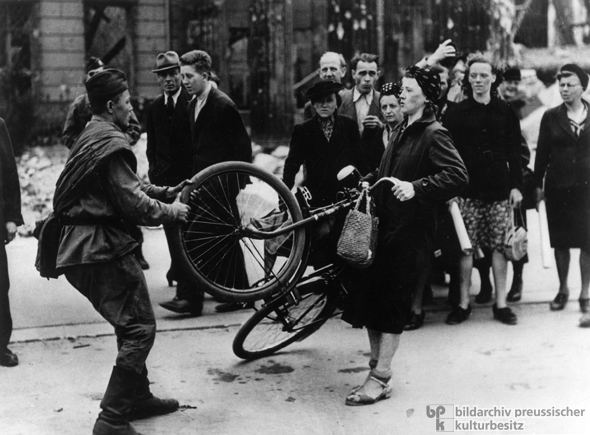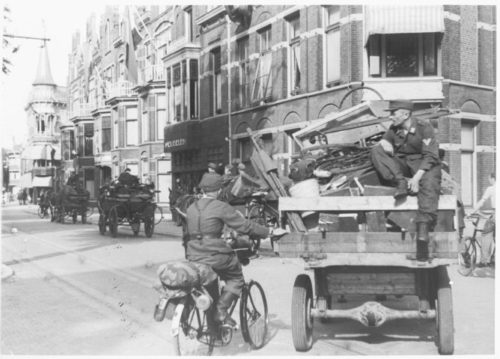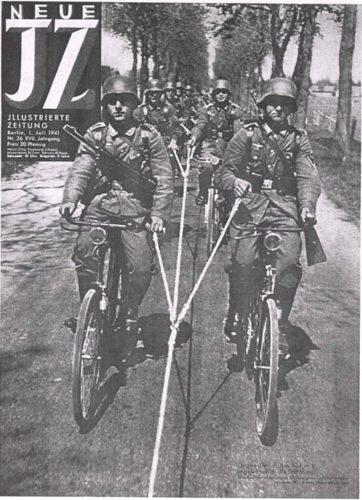After Soviet soldiers had walked on foot an estimated 2,500 km from Stalingrad to Berlin, their sentiment went something like this:
Commandeering a bicycle from Nazis (who literally had stolen everything while initiating illegal war) wasn’t entirely unexpected even if unapproved.
In fact, it was reported that Soviets inside Berlin would not take anything let alone a bicycle away from someone if that person clearly was a victim of Nazis.
I say this all up front because an archival photo below represents something of a de-nazification problem within a constant false victim narrative by fascists.
What do you see here?

Note a crowd stands aside and looks silent (a failure to Raleigh — pun obviously intended), which gives a rather obvious clue about this woman.
Nazis were notorious for stealing bicycles even before and throughout WWII, particularly in rural areas and from elderly women (people who needed them most).

Or as they say in Dutch…
“Hé, waar is mijn fiets”? […] Het klopt dus dat de Duitsers de fietsen van veel Nederlanders inpikten. Want in laten leveren en niet teruggeven is een vorm van stelen.
Roughly translated:
On July 28, 1942 the Nazis stole all the bikes in Amsterdam by demanding the Dutch “surrender” them forever. Allegedly after invading and occupying a city Nazis would forcibly collect all the bikes not least of all to monopolize mobility and send metal back to Germany to be melted into weapons to invade more cities… a vicious cycle (pun obviously intended).
In Copenhagen when Nazis stole all the bikes it was reported as being luckier than those in Amsterdam:
…Hitler personally approved mass bike theft in Denmark. And it could have been worse as his original orders had been for all bicycles to be taken.
Sentiment about Germans stealing bikes is particularly bad because very overt campaigns intended to centrally control all rights including freedom of movement.
Liberating Soviet soldiers thus were seen as restoring freedom in Germany by prying hands off bikes where there was no proof of ownership (e.g. stolen by Nazis). Credentialed owners of bicycles, especially the victims of German crimes, were allowed to ride again thanks to this process of denazification.
For more insight into the situation after liberation, a book called “Unbroken Chain” by Holocaust survivor Henry Oertelt explains from a personal view — in Berlin he rode one around without any hassle from Soviets.

Guess where that “beautiful shiny bike” came from? Probably stolen.
More to the larger point about Nazis, they had given Germany a reputation of being lazy, petty thieves who hated hard work and invaded neighbors in every direction to loot everything.
Also consider this WWII photograph:

Who today looks at that horse-hitch-looking thing and thinks “taking a hand off the bars of a stolen bicycle to hold onto short rope with no room to ride (instead of just pedaling) seems like a great idea”? It’s like a bad joke from someone whose army in 1942 was 80% un-mechanized and relied on horses.
How would these men scatter? It’s actually a good illustration of bicycle formations in war leading straight to failure.
…when a Japanese bicycle unit of about 300 moved on the Luzon Plain on Manila in December 1941 they were easily handled by defenders. Filipino riflemen accompanied by American armor made quick work of Japanese cyclists as they attempted to ride into withering fire. Even as bikes scattered or turned to ride in retreat nearly all were eliminated.
Seriously, anyone with an ounce of common sense would never do this. Instead they should just stack people and bikes on a motorized/armored rack/trailer. It’s not like Nazis didn’t know how to rack and stack bikes for a long haul since that’s exactly what they were doing when stealing everyone else’s. Of course that goes back to the problem that the Nazis didn’t even know what to do with the bicycles after they stole them, as they had the least modern military in WWII — only about 1/4 mechanized.
Now what do you see in that first image?
The German woman appears to be a common criminal in Berlin refusing to give up a stolen bike. It’s a good lesson for disinformation analysts.
It matters whether this was stolen by Germans or not because the Nazis were robbing raping and killing random people with no intention of allowing justice. So dont look for deeper reasons here. The people liberated from labour camps and other slaves returning to their cpuntries (e. g. Poland) had been robbed and raped for years. And this did not change till today (Ukraine 2022).
Keep writing truths. German cruelty then is like Russian cruelty today. This are equivalent regimes.
And why people dont react? They survived. Nazis already killed anyone who dared to stand up